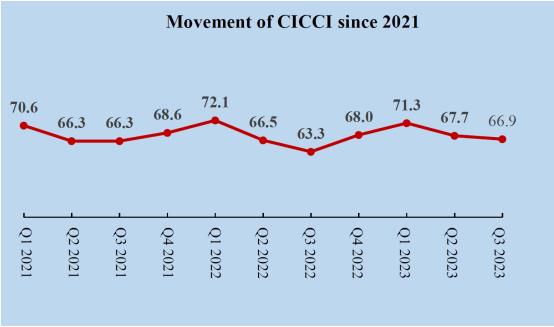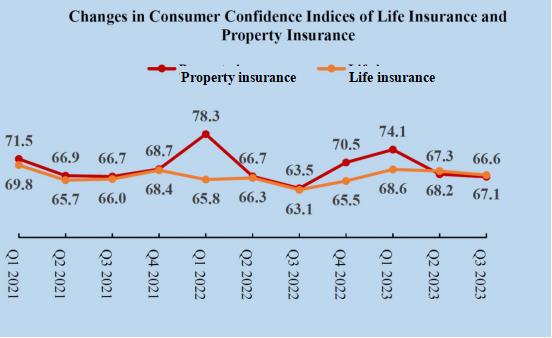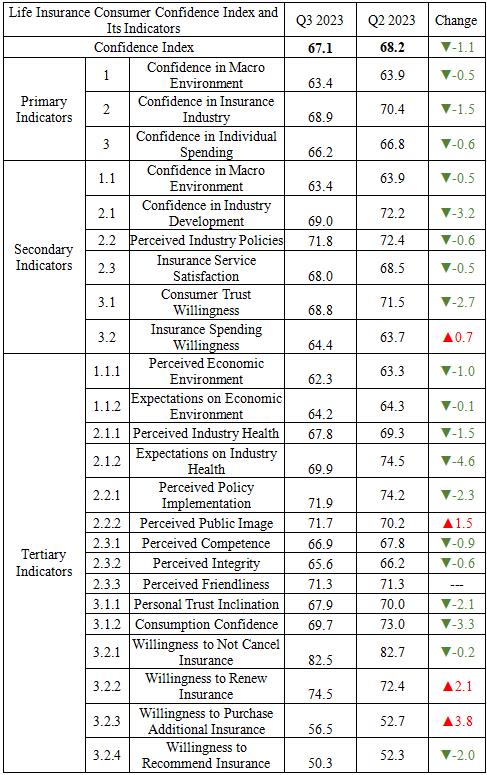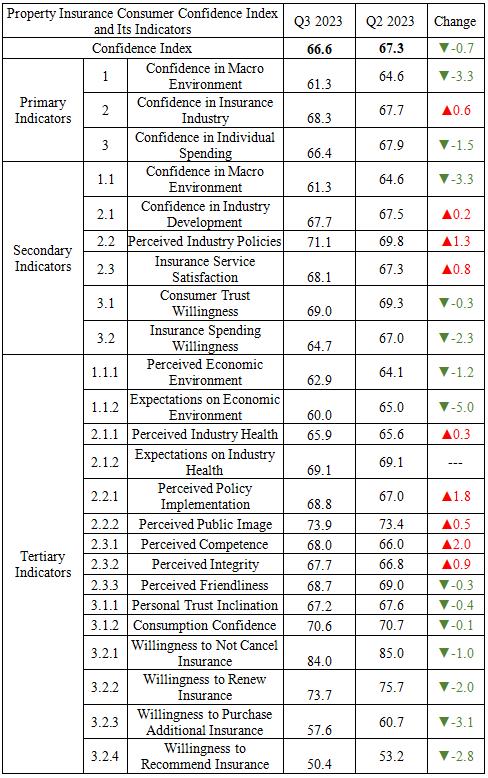
The China Insurance Consumer Confidence Index (CICCI) in Q3 2023 was 66.9, representing a decrease of 0.8 from Q2 2023 and an increase of 3.6 over Q3 2022 and staying within the high confidence range ((65,85]). In the first three quarters of this year, CICCI always remained in the high confidence range and surpassed the levels in the same period of 2021 and 2022. As insurance consumers continued to recover confidence, insurance consumption came on an increasingly solidified footing.

Figure 1 Movement of CICCI since 2021
In terms of insurance types, the consumer confidence index of life insurance and the consumer confidence index of property insurance in Q3 2023 were 67.1 and 66.6 respectively, both of which stayed in the high confidence range and showed the trend of a quarter-on-quarter drop and a year-on-year rise.

Figure 2 Changes in Consumer Confidence Indices of Life Insurance and Property Insurance
For life insurance, the consumer confidence index was 67.1 for the third quarter, down 1.1 from the previous quarter and up 4.0 over the same period of the previous year, which stayed in the high confidence range. Its indicators showed the following trends. First, the three primary indicators that make up the index all declined on a year-on-year basis. Specifically, confidence in insurance industry and confidence in individual spending remained in the high confidence range, and confidence in macro environment in the average confidence range. All the three indicators were higher than their counterparts in the same period of 2022, and confidence in insurance industry and confidence in individual spending surpassed the levels over the same period of 2021. Second, of the six secondary indicators that make up the index, insurance spending willingness rose compared with last quarter, while the remaining five declined on a quarter-on-quarter basis. Confidence in industry development, perceived industry policies, insurance service satisfaction, and consumer trust willingness all stayed in the high confidence range.
The consumer confidence index of life insurance in the third quarter was still higher than that in the same period of the past two years, despite a quarter-on-quarter drop. The four secondary indicators that make up the index, namely consumer trust willingness, insurance service satisfaction, insurance spending willingness, and confidence in industry development, all outstripped their counterparts in the same period of 2022 and 2021. Insurance spending willingness went up by 0.7 to 64.4 on a quarter-on-quarter basis, a level close to the high confidence range indicating a stabilizing trend. In spite of a quarter-on-quarter fall, confidence in industry development, insurance service satisfaction, and perceived industry policies were in the high confidence range for four consecutive quarters. Confidence in macro environment and perceived industry policies saw their decline narrow, signaling a stabilizing trend. The aforesaid changes indicated that insurance consumers rebuilt their confidence somewhat, optimistic about the outlook of confidence in industry development, perceived industry policies, and industry service satisfaction.
A Q3 survey showed that 65.2% of life insurance consumers surveyed were willing to purchase additional insurance in the next six months, up 6.1 percentage points on a quarter-on-quarter basis. To be specific, 61.3% of the respondents were willing to purchase additional health insurance (down 2.4 percentage points quarter on quarter), 54.9% were willing to purchase additional accident insurance (down 5.0 percentage points quarter on quarter), and 39.9% were willing to purchase additional life insurance (up 0.7 percentage point quarter on quarter). Life insurance consumers now continue to recover confidence, as exemplified by the fact that the percentage of consumers willing to purchase additional life insurance has increased for five consecutive quarters, thus creating a positive consumer atmosphere for the insurance industry to further develop through transformation. The regulator recently released the Measures for the Administration of Insurance Sales Practices, which would help promote the orderly operation and sound development of the industry. It is recommended that market players seize upon the favorable opportunity presented by the industry transformation to further regulate their insurance sales practices, build a high-caliber team of sales personnel, provide insurance products and services to meet the needs of consumers in health, accident, retirement, and wealth inheritance, among other fields, and promote the high-quality development of the entire insurance industry.
In terms of property insurance, the consumer confidence index was 66.6 for the third quarter, down 0.7 from the prior quarter and up 3.1 over the same period of the previous year, which stayed in the high confidence range. Its indicators showed the following trends. First, of the three primary indicators that make up the index, two went down and one went up. Specifically, confidence in macro environment and confidence in individual spending fell, while confidence in insurance industry rose. Confidence in insurance industry and confidence in individual spending stayed in the high confidence range and confidence in macro environment was found in the average confidence range. All the three indicators were higher than their counterparts in the same period of 2022. Second, of the six secondary indicators that make up the index, three went up on a quarter-on-quarter basis and the contrary is the case for the other three. Confidence in industry development, perceived industry policies, and insurance service satisfaction rose compared with the previous quarter, of which the indicator of perceived industry policies recorded the greatest increase (1.3). Confidence in macro environment, consumer trust willingness, and insurance spending willingness all decreased quarter on quarter. The four secondary indicators, that is, confidence in industry development confidence, perceived industry policies, insurance service satisfaction, and consumer trust willingness, remained in the high confidence range. All of the six secondary indicators outperformed their counterparts in the same period of 2022.
Despite a quarter-on-quarter drop, the consumer confidence index of property insurance in Q3 2023 was still higher than that in the same period of 2022 and close to the level in the same period of 2021 (66.7). Confidence in industry development, perceived industry policies, and insurance service satisfaction stopped falling and started to pick up. They stayed in the high confidence range for four consecutive quarters, higher than the levels in the same period of 2022 and 2021. Confidence in macro environmental and consumer trust willingness saw their decrease narrow somewhat, maintaining the momentum for recovery. The changes of the above indicators showed that property insurance consumers kept restoring confidence. Meanwhile, the willingness to consume insurance still needs to be improved, and confidence recovery needs to come on a further solidified footing.
A Q3 survey showed that 72.0% of property insurance consumers surveyed were willing to purchase additional insurance in the next six months, down 5.8 percentage points on a quarter-on-quarter basis. To be specific, 59.4% of the respondents were willing to purchase additional car insurance (up 1.1 percentage points quarter on quarter), 39.3% were willing to purchase additional account safety insurance (down 2.6 percentage points quarter on quarter), and 38.6% were willing to purchase additional homeowner insurance (up 9.6 percentage point quarter on quarter). The percentage of consumers willing to purchase additional homeowner insurance reached its peak since Q3 2022. The automobile market slowly rebounded in the first eight months of 2023, with new car sales registering a year-on-year increase. At the same time, the percentage of consumers willing to purchase additional car insurance and homeowner insurance went up on a quarter-on-quarter basis. These positive factors would be conducive to the accelerated recovery of the property insurance market. Therefore, it is recommended that industry players focus on various needs for protection against risks to property, actively expand areas covered by insurance, proactively integrate into social risk management, implement risk reduction requirements, and diversify the supply of insurance products. In short, they are expected to attain high-quality development, while serving the entire Chinese economy and society.
The survey data since 2021 show that insurance consumer confidence is prone to seasonal fluctuations, which tends to bottom out in the middle of the year and rebound at the end of the year. It is recommended that industry players implement the new development philosophy on all fronts, pay close attention to how the confidence of different types of consumers changes, help implement various insurance policies in the interest of the Chinese people, continuously foster new growth drivers for insurance consumption, reasonably improve the expectations of insurance consumption, and promote the sustained improvement of the insurance market.
Annex: CICCI Scores for Q3 2023


Notes on the Compilation of CICCI:
China Insurance Consumer Confidence Index (CICCI) survey covers 18 provinces, autonomous regions, and municipalities in Northeast, North, East, South, Central, Northwest, and Southwest China. These regions account for more than 90% of the national net premium written.
This round of survey uses a combination of two-phase stratified sampling, probability proportional to size (PPS) sampling, and random telephone sampling to collect 1,071 valid responses for inclusion in the index, comprising 531 from the life insurance segment and 540 from the property insurance segment. The online survey is completed with a big data-driven sampling frame and an AI-powered call system without human intervention. After a consumer answers the phone call and confirms his/her willingness to participate, the system will automatically send him/her a text message containing a link to the online survey form. This implementation ensures both consumer privacy and first-hand access to feedback.
CICCI gives a value from the [0, 100] range, 50 being the neutral result. A score higher than 50 indicates optimism, i.e. a larger proportion of insurance consumers is optimistic rather than pessimistic. The higher the score, the stronger the consumer confidence. Score ranges have the following meanings: (85, 100]: Very high confidence; (65, 85]: High confidence; (50, 65]: Average confidence; (35, 50]: Below-average confidence; (15, 35]: Low confidence; and (0, 15]: No confidence.

